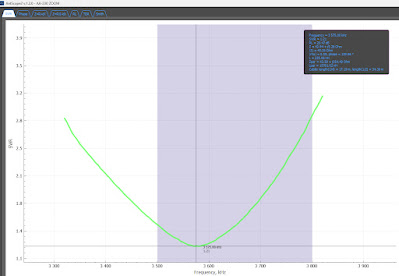I've been playing with end-fed wires for the first time in years these past few days. Not so much because I expect stellar performance, but because I want a simple, easy-to-erect, reasonably effective multiband antenna for International Marconi Day.
 |
| Sunset approaches for the EFHW on 80m. |
To be clear, by end-fed wire, I mean a 49:1 unun connected to a wire half a wavelength long at the lowest frequency to be used and, therefore, not a half wavelength on any other band, contrary to the general 'EFHW' name.
 |
| I bought this to speed-up tests before Marconi Day. A very well-made unit. |
The unun's at the base of a 9m fibreglass pole, with roughly 8.5m of vertical wire, and the rest of the ~20m wire sloping down to ~3.5m above ground via some light rope. You can also call it a sort of inverted-L antenna. As the counterpoise is said to be the coax shield, I guess it's important to say my coax was about 2m to a QRP matchbox, and a further 1m to the WSPrlite transmitter. No other RF grounding was implemented.
 |
| The match through a QRP matchbox, optimised for the WSPR frequency. |
The environment is agricultural soil, damp, completely clear of buildings and overhead wires; an open-field, 'big skies' type of place.
I don't expect to operate on 80m very much during IMD, but it may be useful for some inter-G QSOs. So I set the wire up on that band just before sunset last night, and set it to run on WSPR at 200mW.
How did it go? Well, you need to read the whole post, not just the first bits. You also need to know that obtaining up-to-date, reliable information about antennas in use at other stations is not as easy as it should be (no, you can't just rely on information entered on WSPRnet 13 years ago - and that goes for my own entry!)
 |
| Sunset-to-sunrise spots, 80m, 13-14/04/2023. |
Firstly, most 80m antennas out there in WSPRland seem to be compromise set-ups and, therefore, not especially efficient. This is usually a product of space limitations. Against these - what we may call 'typical' - 80m antennas, the EFHW did OK. Here's my antenna compared to M0GUC, apparently a shortened 160m dipole, for example:
 |
| Distances achieved, 80m. |
 |
| Simultaneous spots, all distances, 80m. |
Comparison with EI4ACB, which may be an end-fed long wire with a good view of the sea to his east, produced similar results, though with less difference between stations:
Where the news isn't so great is when we select the two best stations on 80m WSPR, and compare with those. Again, I don't know for sure what antenna is being used by either of these stations - operators can often change their setups from what is described on WSPRnet.
So, 'good' station number one is G3VAO, which WSPRnet says is a dipole of some sort:
The difference in distances achieved increases through the night, but it's not an enormous difference overall. Where it all breaks down is in consideration of the received signal strengths:
A 17.33dB difference! And not in my antenna's favour. It's a disappointing result, for sure. If we add that much to 200mW, G3VAO is effectively putting out 19.3 Watts.
Good station number two is G8MIA, who seems to be using a trapped 80/30m dipole from a fairly open landscape. Again, the difference in distances achieved is not very great:
But the simultaneous received strengths is large, at just under 15dB. Adding that to 200mW means G8MIA was, in comparison, effectively sending 18.7 Watts.
I've changed my initial conclusion about this antenna, at least so far as the bands down to 40m are concerned. A 40m inverted V, or a sloping dipole, is fairly short at only ~20m overall. This is easily and, arguably more easily erected than the inverted-L, and may even be more effective for short-medium haul contacts. For 80 and 160m, the inverted-L may have the advantage in terms of ease of installation, if not necessarily performance.






No comments:
Post a Comment